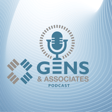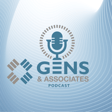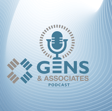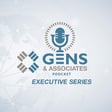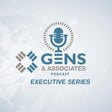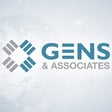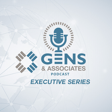Become a Creator today!Start creating today - Share your story with the world!
Start for free
00:00:00
00:00:01

Service Provider Executive Series Episode #5 - Rachel Belani-Barker (Syneos Health)
In today’s episode, host Steve Gens is joined by Rachel Belani-Barker (Managing Partner, R&D Advisory at Syneos Health). Together they discuss supporting client’s transition through data strategy cross functionality, AI service tools, and whats up next for Syneos Health's regulatory/R&D practices.
Transcript
Introduction and Welcome
00:00:00
Speaker
Welcome to the Gens & Associates Regulatory Executive Series Podcast. I'm your host, Steve Gens, Managing Partner. Today, I'm pleased to welcome Rachel Bellani from Cineos Health. So Rachel, welcome. i've Been looking forward to this conversation. you know Certainly, as you know, I have a history with Cineos Health. Actually, back to the KINAPS days where we did some collaboration.
00:00:24
Speaker
on projects and Cineos Health have bought the KINAPS crew and have been doing interesting things with you guys now and then. And you you certainly mean a lot to the regulatory community, so I'm really happy to have you here today. So before we get started, would you like to give an introduction to our listeners, a little bit about yourself and the the practice, the regulatory practice at Cineos Health?
Cineos Health's R&D Advisory Practice
00:00:48
Speaker
Sure. So good morning and thank you, Steve, for the opportunity today. So first, just a little bit of background on Cineos Health and the R and&D Advisory practice. So Cineos Health is more broadly known as a global CRO that provides a variety of clinical and commercial services to industry.
00:01:05
Speaker
But as you mentioned, Cineos Consulting is actually a, came from Kynapse. So it's a more of a boutique consultancy ah that focuses in on regulatory business and technology consulting. And in the last couple of years, we've really broadened our scope to focus more broadly across R and&D. So while we work a lot with our regulatory customers, we also spend a lot of time supporting clinical and clinical data transformations, and have also made our way into the quality space as well.
00:01:35
Speaker
So a little bit about me, I've been in the industry now for over 20 years. I actually started out in industry back at Actelion Pharma, which was now close to 20 years ago, and um really learned the ropes there around clinical development, process and technology. Then made my way into a series of consultancies and startups and even spent some time at Viva Systems, where I was involved with the VaultRIM strategy and deployment.
00:02:00
Speaker
And it's now in the last three years that I found myself back in consulting. And this time at Sineo's where I've been building out our practice and offerings over the last couple of years. Okay, thanks for that intro and other things that come to mind. You had mentioned the ah the quality and we I think one of your subject matter experts and this was about two, two and a half years ago was part of the core team for where we're so known for our regulatory benchmarks where we ventured into quality because I know that that that was a really good collaboration and certainly for our listeners and some of them I'm sure are on your hero forum too you know the heads of regulatory operations so there's a lot that you guys do to give you know give to the regulatory community and to your point the broader you know R and&D community.
Transformation in Regulatory Data Strategy
00:02:45
Speaker
So where I like to start, um you know, there's been so much change in regulatory, you know, the past five or 10 years, you know, some people call it transformation modernization, you know, it's kind of a, you know, replatforming on both the process and the other system ah layers. But, you know, recently, um people had talked what, three to five years ago, regulatory is going from documents to data, but, you know, really, what does that mean? But it's all about the the data.
00:03:13
Speaker
And I know you guys have been doing some unique things, and we're a big ah proponent of cross-functionality about data strategy you know across functions. you know We're seeing things now with looking for automation, you know mastering data you know across R and&D, including regulatory. So it's a really, really interesting time. And I know you guys have been doing a lot of work in that space. So maybe for our listeners, if you could share how Cineos Health has supported clients through this transitioning and this big of data strategy cross functionality that's going on right now. Yeah, absolutely. So, Steve, as you mentioned, this would have been a very different discussion five, even 10 years ago, as most of the time data strategy was focused, um and it was more functionally aligned, right? So, for example, regulatory had their own data strategy and roadmap
00:04:06
Speaker
clinical had their own and so on. It's really in the last couple of years with that we're now in a place where farmers are looking at their data from a pan R and&D perspective and moving away from that ah functional focus or departmental focus. And what I've noticed is that the level of data curation and focus is directly tied to the company size, their geographic footprint and outsourcing mix. So for example,
00:04:31
Speaker
big companies or multinational companies have increased their focus on owning and maintaining their data across R and&D. Whereas smaller companies are headed in this direction too, but there's a lot of them are still focused on owning their own business systems first within R and&D before they can really start thinking about um centralizing their data management strategy.
00:04:54
Speaker
So at Cineo's Consulting, we've helped our clients define cross-functional data strategies, often with an initial focus on supporting IDMP requirements.
AI Integration in Data Management
00:05:03
Speaker
And then in other cases, we're looking more broadly at how do we define a strategy that ah allows for effective sharing of content and data across regulatory, clinical, and and quality business systems.
00:05:17
Speaker
And I think this has really ah been an area of focus for us when it comes to key submission documents and more complex deliverables like the CSR, right, that are they're getting data and documents from various departments within R and&D. And you also started touching on automation, right, or AI. And with AI being one of those hot topics, it's now becoming more integrated into every company's IT and data management strategy.
00:05:44
Speaker
And we've really noticed a maturation of data fabric and warehouses that allow for the broader harmonization of data to occur. ah Previously with this more functional or siloed approach, it wasn't always easy to have a holistic data strategy.
00:06:00
Speaker
And now that we're seeing data fabric becoming more ubiquitous and ah taking that more pan-R&D approach, it's much easier for organizations to develop a strategy that's extensible, that's scalable, and that actually works alongside some change management and understanding how the data um harmonization stewardship should work within regulatory and ah across R and&D functions.
00:06:25
Speaker
And I think lastly, we've also taken some steps to understand what system of record really means um as it pertains to data strategy. ah Because with the change in system ownership, you can have there's a significant impact on the data stewardship, the cleanliness of the data, and the overall quality of your data that ends up in your reports and your oversight.
00:06:48
Speaker
Yeah, thanks for that, Rachel. And what I want to key on and actually have some follow-ups, you know, for you on this. it's out There's just a lot to unpack with what you just said. ah But the term data fabric, so, you know, you're very familiar with the world-class rim, you know, studies. and Like over the years when we work with industry and different members, you know providers like yourselves, just to make sure we have the best survey design. In that section, it was like data lakes, data warehouse, and people have been using data fabrics you know for the last you know year. But what was really interesting when Greg and I looked at it, there's this big, and I think it goes neatly into you know what you're seeing and how you help your clients.
00:07:31
Speaker
is that you know there's less and less system to system connectivity, especially for the large multinationals in the mid tiers. If I get my kind of factoid right, it's around 70% have some type of data lake, data warehouse, call it a data fabric. One person kitted around, we have a data swamp you know because it's all connected. ah But you know it's all connected and they realize how much of a data quality challenge they have.
00:07:59
Speaker
But that seems to be a primary direction, so it's different that if you have a system to system or, you know, like with Viva, vault to vault, you know, different modules, you might be looking at a certain type of consumption or reporting, but it's very, very different on these data fabric, you know, pulling from clinical from regulatory.
00:08:16
Speaker
from safety, quality, R and&D, you know for those change controls, et cetera, et cetera. And as you know from the World Class RIM study, we proved out that the relationship of data quality or high data quality levels comes from mature data governance processes because for time in, time out, and you might get this from your clients too, it's like, well, what's the best data entry strategy strategy. Should we centralize it? Should we do it on forms? Decentralize it to the source or to your point, what is truly the global authoritative source? But it's all about maturity data governance processes. And as you know, they need to be consistent you know across functions. The last point too is you know when you and mentioned the IDMP is driving some of this and I don't know
00:09:04
Speaker
if you have the same experience you know with your client base, because I see it in kind of two categories that will constantly use IDMP to push this change you know to get this cross-functionality, we call it cross-functionality, data strategy, and the the push, the event is IDMP. And we've seen another cohort where ah they know they have to do this strategically anyway, having a really good R and&D, including regulatory data strategy, in that IDMP is just one of the benefits as opposed to the driver. So I don't know um if you have any comment on that before we kind of move on. you You did touch on AI and I have a burning question on that. But any kind of reflection based on kind of that IDMP point and kind of how we see
IDMP and Data Strategy Enhancement
00:09:49
Speaker
it, I'm not sure if you see it the same way. Yeah, Steve, I generally i agree where i IDMP becomes or has become
00:09:57
Speaker
the preliminary focus for most of these data strategy and governance efforts. But I say preliminary because it it is just that, right? We know it's a it's a guidance. It needs to be met. But I've also seen organizations tie this into ah the regulatory excellence and other operational improvement initiatives where they want to get to a place where they can actually trust their reports and have more credible reporting on the upcoming submissions. ah they need This governance also allows for them to understand what submissions have been done and the better support responses to RFIs, for example. So it it comes down to building like guess better quality data and being able to trust your data to allow it to support many other initiatives that are adjacent.
00:10:45
Speaker
All right, to IDMP. ah but Most of the focus that I've seen is around better submission strategy, better submission planning and tracking, and then looking at, you know, typical things like reducing cycle times, for example, or compressing the timeline from authoring to submission. So generally agree, and I think IDMP is really just one of those drivers that companies will hang their hat on to get started.
00:11:11
Speaker
Yeah, yeah, certainly. And I yeah have a kind of a chuckle here because when I think of IDMP, I immediately go back to 2015, you know, just 10 years now. Me too. Like everybody was stressed that do we have enough time and especially um And I'm sure you are involved, too, you know with the large multinationals like the top 10, there's no way they can be compliant with IDMP in the manual approach. And that that might even be top 30 on this. So that that need for that cohesive data strategy. And I know you know the really innovative you know companies, you know they're finding multiple three, four, five threads to
00:11:51
Speaker
kind of a cross-functional R and&D regulatory you know data strategy. So so certainly interesting times. So you did talk about AI so that you know you know I have to ask you a question on that.
AI's Impact on Regulatory Services
00:12:03
Speaker
um And actually, ah like everybody, what is the impact you know tactically and strategically of AI? And a lot of it in a lot of our research is focused on you know industry. And we hear a lot like at the FDA and EMA and others kind of how they're seeing the impact. But you know especially over the last two or three months, that what does that mean for services you know kind of firms? Because you know industry always wants tech-enabled services. you know But you know really, what what is that at the end of the day?
00:12:34
Speaker
and how much will AI, you know, because we have a position, you know, that in the next three to four years, there's a potential and regops, you know, indossier builds document generation, about 30% of it can be automated. So there's an impact to the the services firms too, but I know and you've shared with me before that you're developing some really interesting AI service tools, and I think you might even have them in production. so Maybe that's something that you can share with our listeners about what's going on with your ah AI service tools. Sure, absolutely. So I would ah put these into two buckets. So we have tools that we've developed internally to improve or streamline authoring activities and to automate some some of the human activities. right Not all of them is where I want to start.
00:13:26
Speaker
And we've done this both in the clinical and the regulatory space. So starting in the clinical space, we we're really looking at some of the what we saw as big gaps yeah in the way clinical operations runs their business. The first was around the TMF. So looking at the electronic TMF and using generative AI to enable better document classification across all of the document types and languages.
00:13:52
Speaker
ah Many of these documents, as you know, end up in submissions as well. So we were looking at this as an upstream approach to enable better quality and faster um classification of documents within the ETMF.
00:14:07
Speaker
Alongside of that, we're also looking at automating what's called expected document list management. So this is a a concept that you see in the ETMF. It's also present in in many other systems like vault submissions. And the purpose of automating EDLs is to take away the human um interaction that's needed here to build out these lists and then to then maintain them.
00:14:32
Speaker
So we're looking to automate the building and the maintenance of these lists and allow for you know reallocation of effort to other activities like inspection readiness or um oversight.
00:14:46
Speaker
That's one of our key use cases. And we also built a use case that allows ah but using generative AI for rapid summarization of protocol deviation and issue management. So we really want to change the status quo to get clinical trial managers, CRAs out of CTMS reports and into using a Gen AI powered application as an assistant or coach.
00:15:11
Speaker
for understanding the key issues, the trends, and to help them prioritize their day to day. Since on any typical phase two or phase three trial, there can be hundreds of protocol deviations and issues that CTM, CRAs are accountable for managing. So we found a way to use AI to make this easier and and to help prioritize and really see trends and insights related to their study.
00:15:37
Speaker
Now on the regulatory side of the house, our global regulatory affairs and solutions team has recently launched a few use cases. There'll be more coming out about this soon, um right ahead of RSIDM. But at a high level, what there what they've been able to do, and they have results for now as well, is automation of module three, document creation, and auto population of INDs.
00:16:02
Speaker
ah They also have been able to measure at least a 60 to 70% reduction in stability authoring time, which is ah which is great to see this out of the gate for the first iteration.
00:16:15
Speaker
And there's also been efforts using generative AI for generating plain language summaries based on the source documents and for generating narratives. So and but all of this is with the intent of not completely replacing ah human and regulatory SME effort, but to significantly decrease it and give them a better first draft to start with.
00:16:39
Speaker
So ah there's been a lot happening um here in this phase. I'd say 2024 was the year where we were building and hardening applications that back in 22 and 23 were really in in proof of concept mode. And looking ahead now into 2025, we're looking to scale these applications for enterprise use. And some of these applications will be made available as well for our customers externally to adopt as they see fit.
00:17:06
Speaker
Yeah, thanks for that, ah Rachel. And a few things this reminds me of is, and you know I've been covering the space for for a very long time, right? And um it reminds me of the early days, and I think people still have the ISI toolbox, but what what a lot of people before ISI was you know bought,
00:17:26
Speaker
um They you know had a big services and they built their own software when the ECTD came around and it was really for the internal use and then they determine like wow we should make a product and take this out to market and within 18 months of that decision they became the the lead in the market and.
00:17:46
Speaker
You know, my thought in knowing that team, you know, that leadership team so well, if you think about getting feedback on a new tool or piece of software, you know, that it's it's constant. If you're using it internally in an operation, you're getting feedback and you're iterating probably, you know, weekly and all that. So it really matures so much quicker. So the fact that you're using a lot of these tools internally, I'm sure as you're bringing these things out to the market,
00:18:14
Speaker
um They're mature out of the the gate. So that's really exciting. And some of the statistics you're giving that, you know, 60, 70% of the stability, you know, kind of authoring teams. And we have the same viewpoint here that AI is an assistant. We have in our AI automation follow-up study from the world-class rim. That'll be posted probably mid-February.
00:18:38
Speaker
of this year, we have a sentiment question about, you know, is AI an assistant or is it going to take away all these jobs, junior jobs, etc. And it seems like the sentiment has shifted as people are learning more. You know, like you said, having those proof of concepts, the pilot, the accuracy is starting to get there.
00:18:56
Speaker
that it's truly an assistant, and that's where the data is suggesting. And I do like the term you had mentioned as far as the the coach. um you know You probably don't know this, but i'll you know call out to my alma mater, Janssen and Johnson and Johnson. My last thing that I did, Rachel, and this is in the 90s, is oh digitize the trial master file. So as you were going through the use case of the, the, the TMF, you know, it's a classic use case on that. um And back in those days, we're really excited with OMR and OCR just to take those paper CRFs and auto classify them, you know, with OMR, OCR. So kind of where it's at today is
00:19:38
Speaker
is really, really, really exciting. So the clinical people can focus on the clinical work, just not the administration of all the, you know, everything that's in their trial master file. So it seems like there's a lot going on with
Future Plans for Cineos Health
00:19:53
Speaker
you guys. So certainly with these podcasts, I always like to end up, you know, with the future, like, you know, where's the train heading at?
00:20:01
Speaker
Cineos Health over the next couple of years, you know, you have services, but also some unique services and with these and unique service tools, you have the HERO Forum for the Regulatory Community. So what's next at Cineos Health for the R and&D practice and the the regulatory practice?
00:20:20
Speaker
Sure, so let's let's touch on HERO or the heads of RegOps forum. As I think we're we're approaching now 10 years of HERO, which as you know is originally started with by John Cogan. And over the last couple of years, we've expanded our membership as well as our focus on topics. So I know initially there's a lot of discussion around RIM. We've now also started threads around regulatory excellence as well as regulatory AI and data strategy.
00:20:48
Speaker
So looking ahead in 2025, we anticipate doing at least three or four forums this year that showcase updates from ah from the members on these topics and also continue the knowledge share around industry initiative initiatives such as a cumulus and upcoming guidances around ECTD 4.0 and the continued guidances around IDMP.
00:21:11
Speaker
ah Members towards the end of the year expressed a lot of interest in deeper dives into data strategy development and as well as AI strategy integration as these are now becoming household or you know top priorities for most regulatory leaders.
00:21:26
Speaker
And I'm really hoping to hear more right about AI from the regulators of the upcoming RSI-DM conference, especially since FDA just released a draft guidance on the use of AI for the development um and the development of drug and biological products, which also includes, from what I can see in this draft guidance, includes some recommendations around the submission strategy.
00:21:48
Speaker
as well. So I think there's, again, a lot to come in 2025 with scaling, AI for the enterprise and understanding what it means from a reg strategy standpoint. Now, from our practice, so to respond to the R and&D market needs, we've invested heavily in bringing in additional domain SMEs from regulatory clinical data and clinical operations groups. So we're adding Domain SMEs have come to us from industry to bolster our offering development and give our customers direct access to industry experts to either vet or even design their capability and technology roadmaps. And as such, we're also continuing
00:22:30
Speaker
our work and the implementation space. So, to date, a lot of our work has been focused on business process engineering and change management. Looking ahead, we've started to build out capabilities for validation, for integration, as well as the migration strategy so that we can provide more of an end-to-end service for our customers.
00:22:50
Speaker
And on the heels of that, we're integrating AI into almost everything that we do. So we've spent a lot of time this past year with customers on modernizing regulatory intelligence, which often comes with a heavy focus in AI for automating aggregation of reg intel topics, as well as distributing the topics and checking in on the acknowledgement and the updates to these topics over time.
00:23:17
Speaker
So I see 2025 as a year where we we are going to continue investing in and keeping a a close look or a close pulse on the way AI is reshaping the regulatory landscape. Yeah, it's kind of a place your bets, because it's certainly early days. Absolutely. it's right it's really a new era, because again, covering and participating in this space, I hate to say it, 25 years, Rachel.
00:23:46
Speaker
No, I see this as the third era, ah the first era kind of in the early days when people are talking about electronic document management. It was more the ECTD, you know, and the ICH harmonization work that spawned so much change, the regional hubs finally getting standards, just like CDISC and clinical and standards are, you know, great. So that got adopted then, you know, we were in the early days before RIM was even a term with our research.
00:24:15
Speaker
So you have the whole push of RIM, but underneath it all, it was it was about monetization of process systems, you know global RIM capabilities, you know change of operating models. you know And most clients have been through that and they're they're optimizing you know continuous improvement, all those healthy things that you need to do from an operational standpoint. But I like your term is like we're in this era, early days of from regulatory and broadly in R and&D, you know what's the right path to scale AI? you know where Where are those benefits going? And yeah it'll be interesting where it's at at the end of 2025, because if we just look back in 2024, kind of what some of the thinking was in January to where it ended up, it's it's it's moving quickly. so but But then there's opportunity. It's exciting times on this.
00:25:08
Speaker
So um you know with that said, you know certainly have enjoyed the ah collaboration with Cineos Health you know over the years and look forward to that turn um now continuing. you know You guys have a lot of unique you know kind of services yeah and capabilities. And with some of your ah toolkit now, that's very exciting, I'm sure, for your clients and prospective clients.
00:25:30
Speaker
so Maybe ah some of our listeners want to get a a hold of you, and you know maybe some of them will see you you know down at RSIDM.
Podcast Conclusion
00:25:39
Speaker
So Rachel, what's the best way for them to get a hold of you? Is it you know LinkedIn, the website? um So what would you suggest? Sure. Happy to take messages on on LinkedIn and connect live at RSIDM.
00:25:53
Speaker
All right. And I'm looking forward to seeing you in person there. Geez, it's three to four weeks away. And ah for our listeners, too, if there's any questions you have for again, some associates, just reach out to me on LinkedIn, or you can go to the contact tab of our website. So Rachel, thanks again, very ah rich discussion. And it's really, really interesting.
00:26:17
Speaker
and exciting where you're taking the the practice and some of the additional capabilities. So I wish you the the best of luck in 2025. And thanks so much for joining the podcast series. and Great. Thanks so much, Steve, for the opportunity and look forward to talking again soon.
